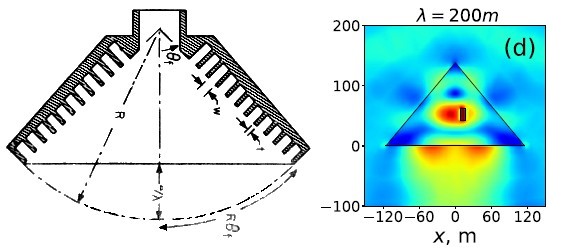 new paper in the Journal of Applied Physics[1] claims that the
chambers of the Great Pyramid in Egypt can “collect, concentrate, and resonantly
scatter electromagnetic energy” inside the pyramid and in the
“substrate region,” i.e. the ground underneath it.
new paper in the Journal of Applied Physics[1] claims that the
chambers of the Great Pyramid in Egypt can “collect, concentrate, and resonantly
scatter electromagnetic energy” inside the pyramid and in the
“substrate region,” i.e. the ground underneath it.
The shape of the Pyramid is remarkably similar to a horn antenna for 200–600 meter (1498.7–499.6 kHz) radio waves, which puts it smack in the commercial American AM radio band (530–1700 kHz). Unfortunately it is pointed in the wrong direction, into the Earth. Is this a mere oversight, or did the builders accidentally build the Pyramid upside-down? Or could the ancient Egyptians, as some ancient alien theorists contend, have been broadcasting down to the underworld? Or could it even be, as some believe, an ancient form of under the horizon ground radar?

The Great Pyramid of Khufu in its current orientation (left) and in the antenna configuration it would need to broadcast to outer space (right). The Great Pyramid was 146.7 m (currently 138.75 m) tall and 230.23 m on each side at its base. The sides make an angle of 51.87 degrees from the ground. Inside the pyramid, above the Grand Gallery, is the “Big Void,” discovered using cosmic ray muon radiography, which is 30 m across.
According to Balezin et al., the Great Pyramid couples more efficiently to the ground than to the air, so the left orientation, where it beams radio waves into the earth, is actually more efficient.
It sounds strange: the Egyptians had no knowledge of electromagnetic radiation as far as anyone knows. Yet using Microwave Studio, a standard software package that does 3D modeling of EM waves, four scientists in St. Petersburg, Russia found maximal scattering cross-sections at wavelengths of 230 and 333 meters (1303.4 and 900.28 kHz). Depending on which direction the waves are propagating, the strongest electrical field is either at the top or the center and base of the pyramid (the latter is shown below).
When the ground beneath the Pyramid is added to the model, the electromagnetic field points straight into the ground, as would be expected for a moderately well designed horn antenna. This raises the question: what stations are down there that they could have been listening to?

Left: Wide-Flare Horn Antenna (from Ref. [3], p. 15-37). The author (R.C. Johnson) says that in a wide-angle scalar horn the pattern calculation becomes considerably more complex than for a small-angle horn. Horn antennas have a high directional gain and relatively wide bandwidth. Right: Distribution of electric field magnitudes of the Pyramid as modeled in free space at 200 meter wavelength (from the article by Balezin et al.) Black rectangle in the pyramid is the King's Chamber. This frequency is about 1500 kHz, the same as News Radio AM 1500 in Honolulu.
I made one of these—a horn antenna, not a great pyramid—when I was in college, using aluminum foil and coat hangers instead of large blocks of limestone, which were not allowed in my dorm room. I tuned the antenna according to the formulas I found in an old book on television [2] to pick up channel 57, which was broadcasting Star Trek at the time. It worked great, except that to get a good signal I had to raise it on boxes seven feet above the floor and attach it to my TV with two pieces of rolled-up aluminum foil, which had to be shorter than ten inches. This made for some uncomfortable viewing. But I would imagine the ancient Egyptians, who by all accounts lacked electricity altogether, faced even greater challenges.
Of course, all antennas can receive as well as transmit. So maybe there's a good reason why the Egyptians pointed their antenna toward the ground: we cannot rule out the possibility that they were receiving transmissions from the mole people. Or perhaps more likely, from Osiris, the Egyptian lord of the underworld, the realm of the dead known as Neher-kherted or Duat. Or, perhaps most likely, maybe this is all just an odd coincidence.
Yeah, that's what they want you to believe.
1. Electromagnetic properties of the Great Pyramid: First multipole resonances and energy concentration. Mikhail Balezin, Kseniia V. Baryshnikova, Polina Kapitanova, and Andrey B. Evlyukhin Citation: Journal of Applied Physics 124, 034903 (2018); doi: 10.1063/1.5026556 Article
2. Robert B. Dome, Television Principles (1951). McGraw-Hill, New York
3. Richard C. Johnson, Antenna Engineering Handbook (1993), 3rd ed. McGraw-Hill, New York. Original diagram from Thomas BM (1978) Design of Corrugated Conical Horns, IEEE Trans. Antennas Propagat., vol. AP-26, March 1978, pp. 367–372.
aug 02 2018, 5:07 am; edited aug 03 2018, 3:59 am
